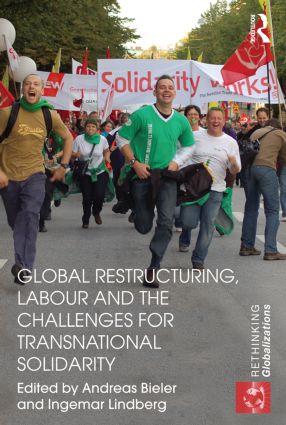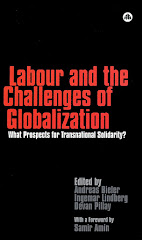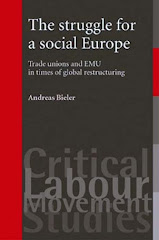Modes of production and forms of exploitation
Banaji’s first main claim is that we should not reduce modes of production, i.e. the social relations of production, to a particular form of exploitation. On the contrary, within a particular mode of production, there will always be a number of forms of exploitation co-existing. ‘The widespread use of slaves in the early middle ages certainly implies a continuance of slavery as a form of exploitation but surely not the survival or persistence of a slave mode of production, however that is construed’ (P.3).
Transferred to our understanding of capitalism, we therefore cannot conclude that wage labour, i.e. so-called ‘free’ labour that has to sell its labour power in order to ensure reproduction, only occurred during the capitalist mode of production or, equally, that any appearance of wage labour automatically implies that a particular historical period must have been part of the capitalist mode of production. Wage labour was clearly present in the ceramics industry within the tributary mode of production in China in the eleventh-century and also ‘widespread in the Roman economy’ (PP.29-30, 117), generally based on slavery. In turn, capitalism still works through a variety of forms of exploitation today not least in the form of bonded labour within wage-labour conditions and various usages of modern slavery.
In short, ‘relations of production are simply not reducible to forms of exploitation, both because modes of production embrace a wider range of relationships than those in their immediate process of production and because the deployment of labour, the organisation and control of the labour-process, “correlates” with historical relations of production in complex ways’ (P.41).
The importance of commercial capitalism?
In his second main contribution, Banaji, accepting that forms of exploitation are not the key markers of particular modes of production, extends the definition of capitalism beyond the sphere of production. Partly, he emphasises the availability of finance, for example from the European colonies in the Americas or India, and a functioning credit system, which was especially developed in Italian city states in the thirteenth to fifteenth century, as key for a capitalist mode of production, (P.260).
And partly his broader definition of capitalism is based on functioning institutions of long-distance trade, which had already been established by the Arab trade-empire at the end of the eighth century. ‘Islam made a powerful contribution to the growth of capitalism in the Mediterranean, in part because it preserved and expanded the monetary economy of late antiquity and innovated business techniques that became the staple of Mediterranean commerce (in particular, partnerships and commenda agreements), and also because the seaports of the Muslim world became a rich source of the plundered money-capital which largely financed the growth of maritime capitalism in Europe’ (PP.267-8).
In this broader definition, Banaji attempts to overcome the distinction between capitalism as a commercial system and capitalism as a mode of production. Going beyond a focus on the way production and thus exploitation is organised in his definition of capitalism, the timeframe of capitalism is significantly extended. ‘Commercial partnerships, bills of exchange, transfer-banking, the widespread availability of money, the growing power of the merchants’ guilds and the evolution of business-firms were all signs of the emergence of a substantial business-economy by the thirteenth century, which it seems strange not to characterise as capitalist’ (P.357).
As a result of his definition of capitalism, Banaji then reaches a novel way of historically delimiting the period of capitalism. ‘The theoretical distinction we need here’, he argues, ‘is one between capitalism in this more general sense, a sense which allows for the commercial capitalism of the twelfth to eighteenth centuries, and what Marx himself called the “capitalist mode of production”’ (P.358).
The continuing centrality of wage labour
At the same time, this should not make us overlook the crucial importance of wage labour in tandem with the private ownership of the means of production as the key marker of capitalism. And in a way, Banaji himself provides a way of how to handle this situation in that ‘we might mark the historical distinction between these early forms of capitalism, dominated by merchants and bankers and the international syndicates they formed, and the developed form of capitalism analysed by Marx in Capital, by describing the former, quite simply, as capitalism or “historical capitalism” and reserving the term “capitalist mode of production” for the latter’ (P.13). Alexander Anievas and Kerem Nişancioğlu clarify this further by pointing out that capitalism as a mode of production refers to a more comprehensive system, which goes beyond the mere existence of some isolated forms of wage labour. Thus, ‘while capital—as we have seen—refers to a social relation defined by the relation between capital and wage-labour, capitalism refers to a broader configuration (or totality) of social relations oriented around the systematic reproduction of the capital relation, but irreducible—either historically or logically—to the capital relation itself’ (Anievas and Nişancioğlu, 2015: 218).
In short, I accept Banaji’s first contribution as helpful for a more detailed and precise understanding of the historical emergence of capitalism. What is, however, misleading in my opinion is to side-line completely the significance of wage labour as main form of exploitation within the capitalist mode of production. It was Marx’s main contribution that exploitation in capitalism did not take place within the sphere of circulation/distribution of wealth, but in the process of production of wealth around wage labour and the private ownership of the means of production. This has allowed us to understand much more precisely the roots of capitalism’s disastrous implications for humanity.
In other words, if we want to understand the inequalities and exploitation characteristic of capitalism, we need to investigate the ‘hidden abode of production, on whose threshold there hangs the notice “No admittance except on business”. Here we shall see, not only how capital produces, but how capital is itself produced. The secret of profit-making must at last be laid bare’ (Marx, 1867/1990: 279-80). Only this will allow us, in turn, to reflect on possibilities of resistance and potential alternatives. Banaji’s notion of commercial capitalism, by contrast, obscures the mechanisms of capitalist exploitation and, similarly to world-systems theory by Immanuel Wallerstein, defines capitalism through a transhistorical description of the commercialisation of trade. As a result, he loses sight of the key dynamics underpinning different epochs within his large historical overview.
Andreas Bieler
Professor of Political Economy
University of Nottingham/UK
Andreas.Bieler@nottingham.ac.uk
Personal website: http://andreasbieler.net
16 October 2017















No comments:
Post a Comment
Comments welcome!